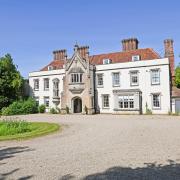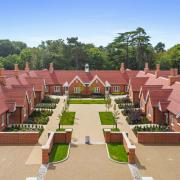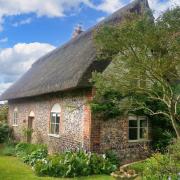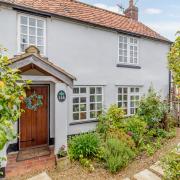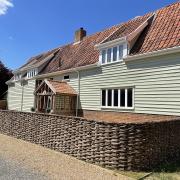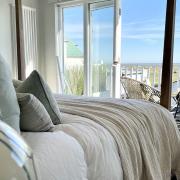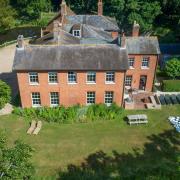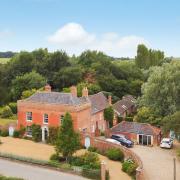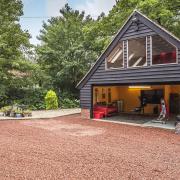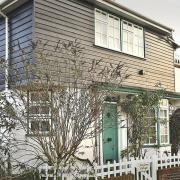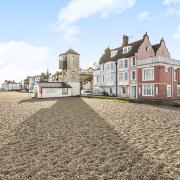Caroline Spurrier discovered ancient family connections when she bought Crow’s Hall near Debenham | Words & Photos: Lindsay Want

Historic Debenham is a secretly superlative sort of place. To the north, near moated Tudor farms and Suffolk’s cider country, the River Deben joins forces with Stony Lane, past Hilly Filly and Henniker Road, creating the longest ford in Suffolk on its final downhill furlong before the medieval wool town.
To the south, as the crow flies, beyond the weaving streets of houses and above the mighty church where Sir Charles Framlingham lays at rest, a little lane climbs the river valley ridge.
It culminates in a half-mile avenue of double-planted vintage oaks and, at its very end, the wonderful discovery of red brick, moated Crow’s Hall. Sitting peacefully by its side, as if undisturbed for centuries, is what is quite believably the longest Tudor barn in the whole of East Anglia.
Crows Hall has been the perfect look-out across the wide, rolling panoramas of the gentle Deben hills since at least the 11th century, and no doubt long before. You can’t help wondering whether John Crow’s Yarmouth shipping family felt all at sea when they landed here in the late 13th century.
Charles Framlingham inherited the site in 1559, acquiring a wife and her dowry just a couple of years later, and soon settled down to feather his Debenham nest, building a fine, fashionable red brick manor.
Parts of it still survive to be seen today, together with the beautiful bridge, gateway, delightful thatched dovecote and extended barn range which appeared in the 1580s, courtesy of his knighthood and position as High Sheriff of Suffolk.

“Hello there!” comes the cheery greeting from within. “Do go across to the barn. I’ll be with you in a minute. Thank you so much.” As promised, lady-farmer and eminent horse-woman Caroline Spurrier soon joins the gathering throng, with a beaming smile, and dogs in tow.
Outside, one end of the long barn reflects on its past in the moat, a gently wavering stretch of mellow brickwork with unusual windows and doorways, dotted with terracotta tiles depicting beasts once stalled within. Inside, it’s a world of towering timbers, propping, leaning, soaring, supporting, creating a vast space.
“It’s 72 metres long in total,” explains Caroline. “Over the years, it has accommodated a brewhouse, a granary, stables and livestock, even servants and soldiers. At one point, it was a court hall and I’m sure it would have witnessed many village celebrations too, but it has always been at the heart of the working farm here.”
The great barn has seen harvests come and go, but these days there’s a chic modern grain store next door, so when not serving as winter storage or workshop for the 400-acre farm, the barn rolls out the carpet to welcome wedding parties looking for the ultimate in authentic backdrops.
A rare survivor, the barn has never lost its original sense of purpose or been sacrificed to the temptations of commercialisation.
There’s no bar or purpose-built kitchen, no fixed fancy lighting or flash terrace. But then, just across the moat, Crow’s Hall has a superb collection of garden ‘rooms’ and these days especially with Caroline’s help, everything else is just a touch of the screen away.

But how to make such a huge space warm and welcoming? “Do let me introduce you to Boudicca. She came to me at about two in the morning and has joined up the thinking on everything.“ Boudicca is a 3 tonne, 200KW biomass woodchip boiler and part of a sustainable future for Crow’s Hall.
She powers the all-important grain-store driers, heats the barn and estate cottages, and thanks to some clever sinking of pipes across the moat, even keeps the Tudor hall nice and toasty too.
There are many more connections below the surface at Crow’s Hall. Like John Crow, Caroline was new to Mid-Suffolk, only pursuing the purchase of the property in 2005 after a strange wake-up call in the middle of the night. “I turned it down originally, but it simply wouldn’t go away,” she shares, standing in the sunshine amid the Pool Garden’s blue delphiniums and white Winchester Cathedral shrub roses.
“I came here one drizzly, cold November morning. I wasn’t sure that I even liked it when I saw it. Tenanted for many years as part of the Thornham Estate, even after a few private owners, it was in a poor state and all I could see were cheque books shredded into the bottom of the moat.” Caroline rang the agents to say ‘lovely thank you, but no thank you’ and continued her country-wide search.
“My father adored Dad’s Army and all Captain Mainwaring’s sparring with Pike. When I was young, if I wasn’t on the ball, he’d tease me gently and call me ‘stupid girl’. That night I woke up to his familiar words, including, ‘Who do you know? What have you learnt? Don’t waste it.’”
With the support of specialist architects and craftsmen who had worked extensively with her family at Easton Lodge estate in Essex, Crow’s Hall turned from a flight of fancy into a feasible renovation project.
If her late father brought his daughter to Crow’s Hall, then perhaps he’d chatted to previous incumbents behind those pearly gates.
Caroline, the great granddaughter of Daisy, Countess of Warwick, soon learnt from the weathered coat of arms above the gate that Sir Charles Framlingham’s grandmother, grand-niece of Warwick the Kingmaker, was in fact ‘family’, and Crow’s Hall was built with the inheritance of some of her very own ancestors.
“I really didn’t know Suffolk before I discovered Crow’s Hall, but my great grandmother, Daisy, spent much of her childhood at Hoxne Hall, not so very far away. I often wonder whether she might have visited. I think she would have liked it here.”
Crow’s Hall is certainly a place that’s comfortable in its own company, yet with an almost tangible history of hospitality. At night, it’s still as dark and quiet as it has ever been, even though it’s now subtly switched on to the 21st century.
Inside the renovated hall, personal touches like the greyhound motif above the dining room fireplace can’t help but catch the eye. Outside, the rooms especially designed by landscape gardener Xa Tollemache are gently traditional, highly practical and beautifully just right.
Caroline may say that the farm, the horses and the dogs rule the roost here, but its clearly a historic place which she loves to share and which, above all, she is very comfortable to call home.
More invitation to view:
Crow’s Hall, Debenham: May 8, June 5.
Columbine Hall, Stowupland: 29 May, July 9, 18, 28, August 7,9.
West Stow Hall, Mildenhall:, May 14,16, June 12, 16, July 8 Sept 26 .
Layer Marney Tower, Tiptree (Essex):, May 22, July 7, August 8, Sept 18, Dec 5.
Old Hall, South Burlingham (Norfolk): May 7, June 24, July 5, Oct 9, Dec 20.
Info & tickets: invitationtoview.co.uk T: 01946 690823. From £15 per person. All tours include light refreshments.




